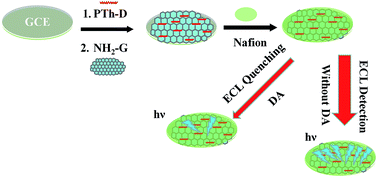Electrochemiluminescence sensor based on cationic polythiophene derivative and NH2–graphene for dopamine detection
Abstract
In this study, a novel electrochemiluminescence (ECL) sensor was fabricated based on cationic polythiophene derivative poly[3-(1,1′-dimethyl-4-piperidinemethylene)thiophene-2,5-diyl chloride] (PTh-D) and NH2–graphene (NH2–G) for detection of dopamine (DA). PTh-D, which has advantages of high electrochemical stability, easy excitation, good water-solubility and good conductivity, and was used as luminescent material in an ECL assay. In the presence of NH2–G, the ECL signal of PTh-D was significantly improved due to its efficient electron transfer. To obtain a stable ECL signal, Nafion was dropped on the surface of the modified electrode. Under the optimum experimental conditions, the ECL signal linearly decreased with the increase of DA concentration in the range of 0.1–50.0 μM with a detection limit of 0.04 μM. This simple prepared ECL sensor exhibited high sensitivity, selectivity, good reproducibility and long-term stability. The applicability of the proposed ECL sensor was also evaluated by detecting DA in real samples. This proposed method not only expands the application of PTh-D, but also opens new doors toward the detection of DA.


 Please wait while we load your content...
Please wait while we load your content...